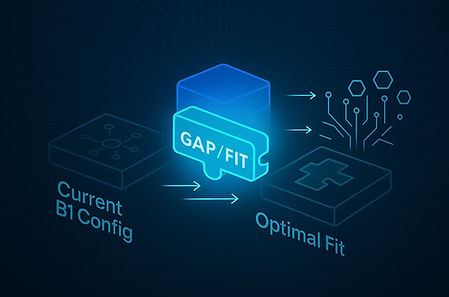Gap/Fit Analysis:
Why Your SAP Business One System Needs It Now
What is Gap/Fit Analysis?
A Gap/Fit Analysis evaluates how your current SAP Business One configuration matches against optimal best practices and your CURRENT business goals. It clearly identifies what's working, what's not, and what needs improvement.
.jpg)
Why would you need one?
Company’s systems are configured during their implementation to a specific point in time.
There are only two-times they are generally changed thereafter:
-
During new process implementation. An example is a company starting to take on some
of their own manufacturing processes, such as assembly or kitting. -
During key new personnel changes. Company X changes CFO’s. The new CFO is used
to doing things his way, so he “adjusts” the system for his use. This can happen multiple times in key areas, depending on stability of the company.
Effect of Changes
Key processes are often short-cut, as the users setting up these processes and changes are only looking at things in a vacuum, how things affect them. However, in an integrated system, by definition, changing things in one area always has an effect downstream.
Result
Over years of these changes, the system is often unrecognizeable and undocumented. People know what they are doing, but often don’t know why. And, they certainly don’t understand how their process could be affecting someone else, as that’s often not in their purview.
In one Orphan we took over, they had multiple accountants come through. By the time we did a Gap/Fit Analysis, I asked my consultant, “Well, how does it look?”
She responded, “It’s like working on Frankenstein. There are accounts all over the place. You can tell it wasn’t set up by one person, as there is just no rhyme or reason to it at all.”
Summary:
-
Invariably, when asked, prospects will tell me: If we knew then, what we know now, we would setup the system completely different.
-
Our business has grown and changed drastically over the years. We are now more ecommerce focused. (insert new market focus here).
-
We have taken over or been acquired.
-
We have had several key personnel changes.
-
I feel like we aren’t as efficient as we could be or we are wasting a lot of time doing x…
All of these are signs your business could be ripe for a Gap/Fit analysis. Open up the hood and make sure your system is tuned to how you need to run it today and in the future. Not to how you were doing business 15 years ago.
When is a good time to do a GFA?
-
Look at your business cycle. The best time to do it is when you have time to really dig in and give it your attention. Don’t pick your busiest time of the year or when you are already under fire with an audit or closing year end. It won’t require the full attention of anyone. But, it will require the partial attention of a couple key people at times, so you need to make sure that you give it the attention it deserves.
-
When you change Partners. This is a perfect time to get fresh eyes on your system and often a good time to do an initial light weight project to get to know how your new team operates under working conditions.
The second benefit is the new team is able to document your processes to also support you better in the future. Remember, they are coming in blind. They are either going to document it as part of the support process, when they are under fire and trying to fix your issue. Or, they are going to get familiar with the system and possibly recommend some changes before they cause issues. The latter is always preferred.
What are the results of a GFA?
The result can just be a health check and summary of your configurations for the new partner.
However, we generally see two areas the results can fall into.
-
Low-hanging fruit. Often, especially with employee turnover, the consultant can uncover low hanging fruit that can range from unknown shortcuts, improved data views, adding fields or
making small corrections that have big value to individual users. -
A list of future enhancements or process changes that can be sorted by the customer in terms
of personal ROI or interest.
The ROI of various recommendations is not always noticeable to the consultant. They may recommend a change and Sally in accounting says, “Oh, you can do that? That’s great, it would save me about 6 hours a week.”…..and then it’s monetized.
This is one of the reasons to make sure key personnel are involved to discuss what’s working,
what’s not working, if they had a magic wand, what would they want?
But, I would highly recommend the customer have a separate meeting, go through all of the proposed changes, see what changes mean the most to them, and then put together a plan for on-going improvements.
A company should always be striving to do better. But, it all doesn’t have to be done in one day.
Map out your continuous improvement on a quarterly basis and you will be amazed at how much improvement can be gained year over year.




.jpg)
.png)
